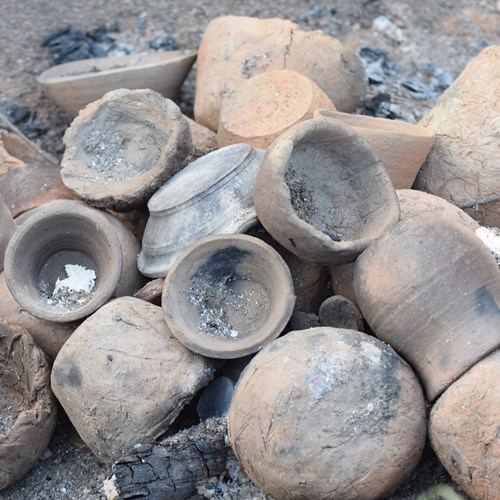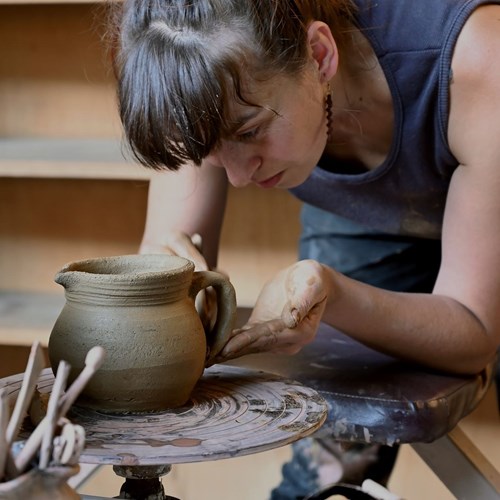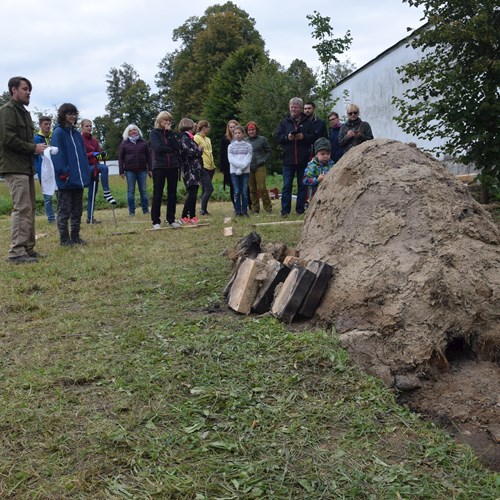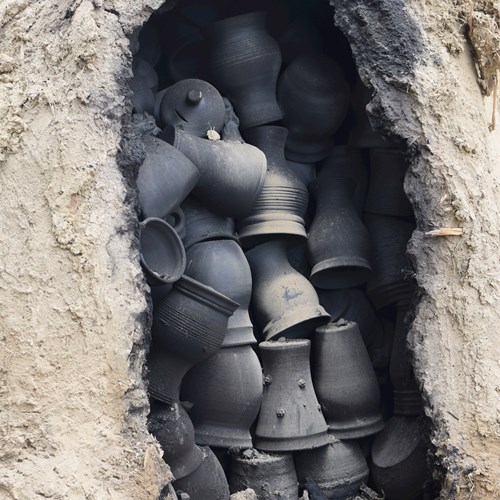Historical pottery: Experimental season 2020
Exactly like all the other spheres of life, the 2020 season of experimental pottery making was affected by the COVID-19 pandemic and the related measures. The 11th Medieval and Modern Pottery Workshop at Panská Lhota near Jihlava as well as the event Den venkova (Rural Day) in the Chateau Žďár nad Sázavou, where the production of smoke-fired pottery should have been presented to the public, were cancelled.
In the first half of 2020, experiments under the auspices of the UNESCO Chair were conducted at the Scientific Research Centre of the Department of Archaeology and Museology, Faculty of Arts, Masaryk University at Panská Lhota near Jihlava. The processing of regional clay sources was continued, including the preparation of graphite-tempered clay bodies for the planned experiments with pottery shaping. At Panská Lhota, three experimental firings have taken place. The first two firing procedures in collaboration with J. Petřík and K. Adameková (NeoPot project) were focused on fast dynamic open-pit firing and on pottery with organic additives (Fig. 1a). The last firing with a fast progress was conducted in a clamp kiln.
The processing and examination of regional brick clays and the assessment of their suitability for pottery making were also continued. One part of the prepared regional clay bodies underwent thermal analysis with the aim to find out the content of kaolinite and clay minerals. The thermal analysis was conducted by Mgr. Dalibor Všianský Ph.D. from the Department of Geological Sciences, Faculty of Science, Masaryk University in Brno. The detected properties indicate that the analysed clay bodies might be used as a ceramic raw material, although the content of clay minerals was relatively low and they can be classified as non-loess brick clays. Some of the clay bodies were already usable in practice with regard to their advanced state of processing. They were tested in production of ceramic vessels with various shaping techniques. The clays proved to be also suitable for wheel-throwing, but their properties are quite different from present-day wheel-throwing clays (Fig. 1b). The most problematic issue, with regard to medieval pottery, seems to be the making of a sufficiently thin wall.
During summer, a collaboration began with Chateau Žďár nad Sázavou within the prepared project Chytrá ruka (Smart Hand), which is targeted at revival of old crafts and their presentation to the public, mainly in the form of practical workshops. During the July and August, a pottery kiln (1c) was built in the area of Forota (behind the curtain wall), based on the find from Křížová Street in Jihlava. This type was already several times reconstructed in the past. The current version differs from the previous ones by the aboveground part. The stone foundations and the vault above the fire mouth were again domed by a wattle armature daubed with clay. With regard to the dimensions of the firebox, a large loading hole was left in the rear part. This hole is walled up before firing and is reduced to a flue hole. This is an innovation in comparison with previous versions of the kiln, which were loaded only through the flue. The first firing in the kiln was carried out in September, although the public event where it should have been presented was cancelled. The kiln had to be fired before winter to stabilize its construction. Moreover, it was planned to use the fired pottery as a charge in the replica of a kiln within a potter’s diorama in the exhibition Triple Life of Medieval Pottery in the Moravian Museum in Brno (1d). The first historical pottery workshop for the public was held within the project Chytrá ruka (Smart Hand) in October, including the throwing of vessels on a kick wheel, modelling of ceramic sculptures or mould-pressing of the frontal heating panels for stove tiles.
Although the main events were cancelled, the 2020 season can be considered successful. A major shift forward was made with processing of regional clay bodies, which are necessary for further progress of experiments with shaping and firing of pottery. The collaboration with Chateau Žďár nad Sázavou considerably enhances the popularisation possibilities of historical pottery as tangible cultural heritage.
Fig. 1: Photographic documentation of the experimental season 2020: a) open-pit pottery firing; b) E. Nová making a ceramic jug; c, d) the first firing of smoked pottery and unloading of the kiln at Žďár nad Sázavou.
Kateřina Těsnohlídková (Department of Archaeology and Museology, Faculty of Arts, Masaryk University)
Karel Slavíček (Faculty of Science, Masaryk University)



